CHAPTER XIII. Part TWO
The first glimpse of Cold Spring village from the road is from the northern slope of an eminence thickly sprinkled with boulders, which commands a perfect view of the whole amphitheatre of hills, and the river winding among them. We turned into a rude gate on the left, and followed a newly-beaten track to the brow of this eminence, on the southern verge of which Rossiter, the eminent painter (a copy of whose picture of 'Washington at Mount Vernon' was presented to the Prince of Wales at the National Capitol in 1860), is erecting an elegant villa. The house was nearly completed, but the grounds around were in a state of transition from the ruggedness of the wilderness to the mingled aspects of Art and Nature, formed by the direction of good taste. It is a delightful place for an artist to reside, commanding one of the most extensive and picturesque views to be found in all that Highland region. The river is seen broken into lakes, in appearance; and on all sides rise in majesty the everlasting hills. Only at one point--a magnificent vista between Mount Taurus and the Storm King--can the world without be seen. Through it a glimpse may be had of the beautiful country around Newburgh.
Below us we could hear the deep breathing of furnaces, and the sullen, monotonous pulsations of trip-hammers, busily at work at the West Point Foundry, the most extensive and complete of the iron-works of the United States. Following a steep, stony ravine that forms the bed of a water-course during rain-storms, we descended to these works, which lie at the head of a marshy cove, and at the mouth of a deep gorge, through which flows a clear mountain stream called Foundry Creek. We crossed the marsh upon a causeway, and from a rocky point of Constitution Island obtained a good panoramic view of the establishment. Returning to the foundry, we followed a pleasant pathway near the bay, into a large grove spared from the original forest, in which are situated the dwellings of a former and the present proprietors of the works.* : One of these, the honourable Gouverneur Kemble, an intimate and life-long friend of Irving and Paulding, and a former proprietor, withdrew from active participation in the business of the establishment several years ago, and is now enjoying life there in elegant retirement, and dispensing a generous hospitality. He has a gallery of rare and excellent pictures, and a choice library; and is surrounded by evidences of refined taste and thorough cultivation.
* The West Point Foundry was established in 1817, by an association organized for the chief purpose of manufacturing heavy iron ordnance, under a contract with the government. That yet formed a large portion of its business in 1860. The works then consisted of a moulding house; 1 gun foundry; three cupolas and three air furnaces; two boring mills; three blacksmiths' shops; a trip-hammer weighing eight tons for heavy wrought iron-work; a turning shop; a boiler shop; and several other buildings used for various purposes. The quantity of iron then used varied with the nature and demand of work. Upwards of fifty tons of pig metal had been melted for a single casting. The annual consumption varied from 5,000 to 10,000 tons, with about 1,000 tons of boiler-plate and wrought-iron. The number of hands then employed was about 500. Sometimes 700 men were at work there. The establishment is conducted by Robert P. Parrott, Esq., formerly a captain of ordinance in the United State Army, and the inventor of the celebrated "Parrott gun," so extensively used, as among the best of the heavy ordinance, during the late Civil War. These, with appropriate projectiles, were manufactured in great numbers at the West Point Foundry, during the war, from 1861 to 1865.
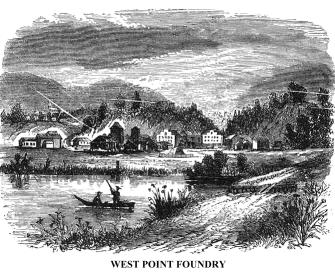 Leaving
the residence of Mr. Kemble at twilight, we made our way through the grove,
and the village of Cold Spring beyond, to "Undercliff," the summer
dwelling of America's best lyric poet, George P. Morris, who has since been
numbered with the dead. Broad Morris Avenue leads to a spacious iron gate,
which opens into the grounds around "Undercliff." From this, through
an avenue of stately trees, the house is approached. It is a substantial edifice
of Doric simplicity in style, perfectly embowered when the trees are in full
leaf, yet commanding, through vistas, some charming views of the river and
the neighbouring mountains. Northward, and near it, rises Mount Taurus, with
its impending cliff that suggested the name of the poet's country seat. It
is the old "Bull Hill" which, in Irving's exquisite story of "Dolph
Heyliger," "bellowed back the storm" whose thunders had "crashed
on the Donder Berg, and rolled up the long defile of the Highlands, each headland
making a new echo."
Leaving
the residence of Mr. Kemble at twilight, we made our way through the grove,
and the village of Cold Spring beyond, to "Undercliff," the summer
dwelling of America's best lyric poet, George P. Morris, who has since been
numbered with the dead. Broad Morris Avenue leads to a spacious iron gate,
which opens into the grounds around "Undercliff." From this, through
an avenue of stately trees, the house is approached. It is a substantial edifice
of Doric simplicity in style, perfectly embowered when the trees are in full
leaf, yet commanding, through vistas, some charming views of the river and
the neighbouring mountains. Northward, and near it, rises Mount Taurus, with
its impending cliff that suggested the name of the poet's country seat. It
is the old "Bull Hill" which, in Irving's exquisite story of "Dolph
Heyliger," "bellowed back the storm" whose thunders had "crashed
on the Donder Berg, and rolled up the long defile of the Highlands, each headland
making a new echo."
A late writer has justly said of "Undercliff"--"It
is a lovely spot-- beautiful in itself, beautiful in its 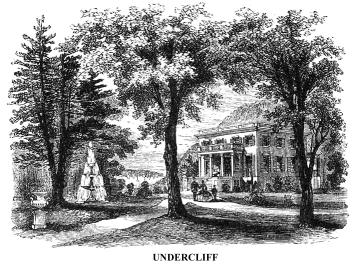 surroundings,
and inexpressibly beautiful in the home affections which hallow it, and the
graceful and genial hospitality which, without pretence or ostentation, receives
the guest, and with heart in the grasp of the hand, and truth in the sparkle
of the eye, makes him feel that he is welcome." Over that household,
a daughter, the "fair and gentle Ida," celebrated in the following
beautiful poem, presided for several years:--
surroundings,
and inexpressibly beautiful in the home affections which hallow it, and the
graceful and genial hospitality which, without pretence or ostentation, receives
the guest, and with heart in the grasp of the hand, and truth in the sparkle
of the eye, makes him feel that he is welcome." Over that household,
a daughter, the "fair and gentle Ida," celebrated in the following
beautiful poem, presided for several years:--
"Where Hudson's wave oe'r silvery sands.
Winds through the hills star.
Old Cro' Nest like a monarch stands
Crowned with a single star!
And there, among the billowy swells
Of rock-ribbed cloud capped earth.
My fair and gentle Ida dwells
A nymph of mountain birth.
"The snow flake that the cliff receives
The diamond of the showers,
Spring's tender blossoms, buds and leaves
The sisterhood of flowers,
Morn's early beam, eve's balmy breeze
Her purity define;
Yet Ida's dearer far than these
To this fond breast of mine.
"My heart is on the hills. The shades
of night are on my brow
Ye pleasant haunts and quiet glades.
My soul is with you now!
I bless the star-crowned Highlands, where
My Ida's foodsteps mean:
Oh for a falcon's wing to bear
Me onward to my home!"
Between Cold Spring and West Point lies a huge rocky island, now connected to the main by a reedy marsh already referred to. It was called by the Dutch navigators Martelaer's Island, and the reach in the river between it and the Storm King, Martelaer's Rack, or Martyr's Reach. The word martyr was used in this connection to signify contending and struggling, as vessels coming up the river with a fair wind would frequently find themselves, immediately after passing the point of the island into this reach, struggling with the wind right ahead.
The Americans fortified this island very early in the old war for independence. The chief military work was called Fort Constitution, and the island has ever since been known as Constitution Island. It contains very little arable land, and is chiefly composed of rugged rocky heights, every one of which now bears the ruins of the old military works. To its shore nearest approaching West Point the Great Chain, which we have already considered, was fastened; and upon a high bluff near (delineated in the sketch) are yet seen the remains of a heavy battery--a part of Fort Constitution--placed there to protect the river obstructions.
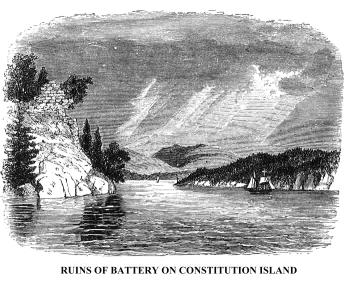 At
the time of my visit, Constitution Island belonged to Henry Warner, Esq.,
the father of the gifted and popular writers, Susan and Anna B. Warner.* They
resided in a pleasant cottage, near the southern border of the island. Its
kitchen was one of the barracks of Fort Constitution. It fronted upon a beautiful
lawn that slopes to the river, and was sheltered by evergreen and deciduous
trees, and beautified by flowers and shrubbery. Although within the sound
of every paddle upon the river, every beat of the drum or note of the bugle
at West Point, every roll and its echo of trains upon the railway, "Wood
Crag," as their secluded residence was called, was almost as retired
from the bustling world as if it was in the deep wilderness of the Upper Hudson.
It is a charming home for a child of genius.
At
the time of my visit, Constitution Island belonged to Henry Warner, Esq.,
the father of the gifted and popular writers, Susan and Anna B. Warner.* They
resided in a pleasant cottage, near the southern border of the island. Its
kitchen was one of the barracks of Fort Constitution. It fronted upon a beautiful
lawn that slopes to the river, and was sheltered by evergreen and deciduous
trees, and beautified by flowers and shrubbery. Although within the sound
of every paddle upon the river, every beat of the drum or note of the bugle
at West Point, every roll and its echo of trains upon the railway, "Wood
Crag," as their secluded residence was called, was almost as retired
from the bustling world as if it was in the deep wilderness of the Upper Hudson.
It is a charming home for a child of genius.
* "Miss Susan Warner," says Duyckinck, in the Cyclopedia of America Literature," "make a sudden step into eminence as a writer, by the publication, in 1849, of 'The Wide, Wide World,' a novel in two volumes." her second novel was "Queechy." She is also the author of a theological work entitled "The Law and the Testimony." Her sister is the author of "Dollars and Cents," a novel; and several very pleasing volumes for young people. "The Hills of the Shatemuc," a tale of the Highlands; is the joint production of these gifted sisters.
On a pleasant morning in October, while the trees were yet in
full leaf and brilliant with the autumnal tints, 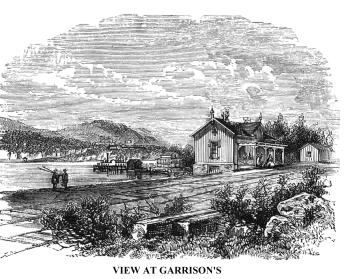 we
went from our home to Garrison's station on the Hudson River Railway, and
crossed to Cozzens's, a summer hotel in the Highlands, about a mile below
West Point. It was situated near the brow of a cliff on the western shore
of the river, about 180 feet above tide water, and afforded a most delightful
home, during the heat of summer, to numerous guests, varying in number from
two hundred and fifty to five hundred. There, ever since the house was opened
for guests in 1849, Lieutenant-General Scott, the General-in-Chief of the
American army, had made his head-quarters during the four or five warmer months
of the year. It was a place of fashionable resort from June until October,
and at times was overflowing with guests, who filled the mansion and the several
cottages attached to it. Among the latter was the studio of Leutze, the historical
painter. Only a few days before our visit, it had been the scene of great
festivity on the occasion of the reception of the Prince of Wales and his
we
went from our home to Garrison's station on the Hudson River Railway, and
crossed to Cozzens's, a summer hotel in the Highlands, about a mile below
West Point. It was situated near the brow of a cliff on the western shore
of the river, about 180 feet above tide water, and afforded a most delightful
home, during the heat of summer, to numerous guests, varying in number from
two hundred and fifty to five hundred. There, ever since the house was opened
for guests in 1849, Lieutenant-General Scott, the General-in-Chief of the
American army, had made his head-quarters during the four or five warmer months
of the year. It was a place of fashionable resort from June until October,
and at times was overflowing with guests, who filled the mansion and the several
cottages attached to it. Among the latter was the studio of Leutze, the historical
painter. Only a few days before our visit, it had been the scene of great
festivity on the occasion of the reception of the Prince of Wales and his
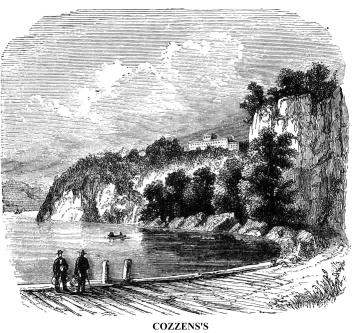 suite, who
spent a day and a night there, and at West Point, enjoying the unrivalled
mountain and river scenery that surround them.
suite, who
spent a day and a night there, and at West Point, enjoying the unrivalled
mountain and river scenery that surround them.
The pleasure-grounds around Cozzens's were extensive, and were
becoming more beautiful every year. They had been redeemed from the wilderness
state, by labour, within ten years. We remember passing through that region
before the hand of man was put forth for its redemption, and seeing the huge
boulders--the "wandering rocks" of the geologist--strewn over the
surface of the earth like apples beneath fruitful trees after an autumn storm.
The change that had been wrought was marvellous. Another was about to take
place. A few weeks after the visit here mentioned, that fine building delineated
in the picture was destroyed by fire. The writer was passing by, in the evening,
on the railway on the eastern side of the river, with a copy of the London
Art Journal in which these sketches were first published, containing this
picture, while the building was in flames. Mr. Cozzens soon erected a more
spacious one on the high rocky bluff overlooking Buttermilk Falls, a very
short distance from the site of the other.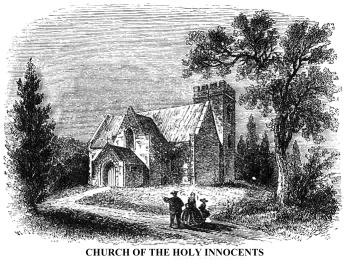
Between Cozzens's and the mountains is a small cruciform stone
church, erected years before the hotel was contemplated, chiefly by the contribution
of Professor Robert W. Weir, of West Point, the eminent historical painter,
and one of the best of men in all the relations of life. It is really a memorial
church, built in commemoration of his two sainted children, and called "The
Church of the Holy Innocents." For this pious purpose he devoted a portion
of the money which he received from the United States Government for his picture
of 'The Embarkation of the Pilgrims,' now in the Rotunda of the National Capitol.
Divine service, according to the modified ritual of the Church of England,
is hold there regularly, and the seats are free to all who choose to occupy
them. We trust our friend, whose modest nature shrinks from 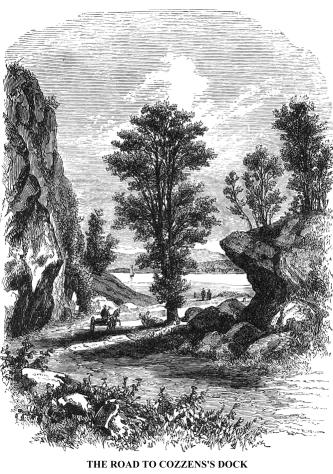 notoriety,
will pardon us for this revelation of his sacred deed. The world, which needs
good teachings, is entitled to the benefit of his noble example.
notoriety,
will pardon us for this revelation of his sacred deed. The world, which needs
good teachings, is entitled to the benefit of his noble example.
All about the cliffs, on the river front of Cozzens's, are winding paths, some leading through romantic dells and ravines, or along and across a clear mountain stream that goes laughing in pretty cascades down the steep shore to the river. The main road, partly cut like a sloping terrace in the rocks, is picturesque at every turn, but especially near the landing, where pleasant glimpses of the river and its water craft may be seen. Altogether Cozzens's and its surroundings form one of the most attractive places on the Hudson to those who seek health and pleasure.
At Cozzens's Dock we procured a waterman, who took us to several
places of interest in the vicinity. The first was Buttermilk Falls, half a
mile below, on the same side of the river. Here a small stream comes rushing
down the rocks in cascades and foaming rapids, falling more than a hundred
feet in the course of as many yards. The chief fall, where the stream plunges
into the river, is over a sloping granite rock. It spreads out into a broad
sheet of milk-white foam, which suggested its name to the Dutch skippers,
and they called it Boter Melck Val--Buttermilk Fall. The stream affords
water-power for flour-mills at the brink of the 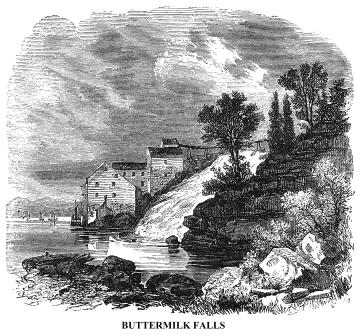 river.
The fall is so great, that by a series of overshot water-wheels, arranged
at different altitudes, a small quantity of water does marvellous execution.
Large vessels come alongside the elevator on the river front, and there discharge
cargoes of wheat and take in cargoes of flour.
river.
The fall is so great, that by a series of overshot water-wheels, arranged
at different altitudes, a small quantity of water does marvellous execution.
Large vessels come alongside the elevator on the river front, and there discharge
cargoes of wheat and take in cargoes of flour.
Rude paths and bridges are so constructed that visitors may view the great fall and the cascades above from many points. The latter have a grand and wild aspect when the stream is brimful, after heavy rains and the melting of snows.
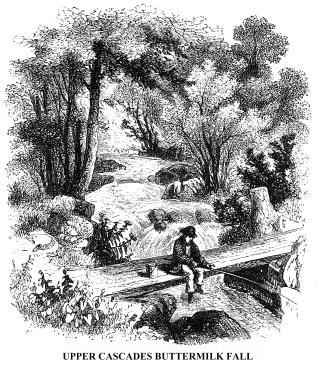 On
the rough plain above is the village of Buttermilk Fall, containing over three
hundred inhabitants. The country around is exceedingly rough and picturesque,
especially in the direction of Fort Montgomery, three or four miles below;
while on the brow of the high river bank near, there are some pleasant summer
residences. Among these was the dwelling of Mr. Bigelow, then the associate
of Mr. Bryant, the poet, in the owner-ship and conduct of the New York Evening
Post, but since appointed, first the Secretary of the American Legation at
the French Court, in 1861, and afterward Minister Plenipotentiary at the same
Court.
On
the rough plain above is the village of Buttermilk Fall, containing over three
hundred inhabitants. The country around is exceedingly rough and picturesque,
especially in the direction of Fort Montgomery, three or four miles below;
while on the brow of the high river bank near, there are some pleasant summer
residences. Among these was the dwelling of Mr. Bigelow, then the associate
of Mr. Bryant, the poet, in the owner-ship and conduct of the New York Evening
Post, but since appointed, first the Secretary of the American Legation at
the French Court, in 1861, and afterward Minister Plenipotentiary at the same
Court.
Here on the smooth faces of the rocks might be seen a desecration which deserves the severest reprobation. All through the Highlands, on the line of the Hudson River Railway, the same offence met the eye. We refer to the occupation of smooth rocks by great staring letters, announcing the fact that one shopkeeper in New York has "Old London Dock Gin" for sale, and that another sells "Paphian Lotion for beautifying the Hair." We protest, in the name of every person of taste who travels upon the river and the road, against any disfiguring of the picturesque scenery of the Hudson Highlands, by making the out-cropping rocks of the grand old hills play the part of those itinerants who walk the streets of New York with enormous placards on their backs, advertising wares for sale; and the Legislature of the State of New York, which, in 1865, made such disfiguration a penal offence, deserves high praise.
We crossed the river from Buttermilk Fall to the "Beverly
Dock," which is interesting only as the place 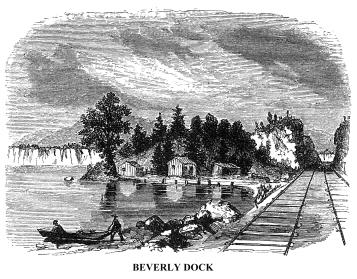 where
Arnold, the traitor, entered his barge in which he escaped to the Vulture
sloop-of-war, on the morning when he fled from the "Beverly House,"
the cause of which we have already considered. Here he kept his barge moored,
and here he embarked on that flight which severed him for ever from the sympathies
of his countrymen--ay, of the world--for those who "accepted the treason,
despised the traitor." His six oarsmen on that occasion, unconscious
of the nature of the general's errand in such hot haste down the river, had
their muscles strengthened by a promised reward of two gallons of rum; and
the barge glided with the speed of the wind. They were awakened to a sense
of their position only when they were detained on board the Vulture as prisoners,
and saw their chief greeted as a friend by the enemies of their country. They
were speedily set at liberty, in New York, by Sir Henry Clinton, who scorned
Arnold for his meanness and treachery.
where
Arnold, the traitor, entered his barge in which he escaped to the Vulture
sloop-of-war, on the morning when he fled from the "Beverly House,"
the cause of which we have already considered. Here he kept his barge moored,
and here he embarked on that flight which severed him for ever from the sympathies
of his countrymen--ay, of the world--for those who "accepted the treason,
despised the traitor." His six oarsmen on that occasion, unconscious
of the nature of the general's errand in such hot haste down the river, had
their muscles strengthened by a promised reward of two gallons of rum; and
the barge glided with the speed of the wind. They were awakened to a sense
of their position only when they were detained on board the Vulture as prisoners,
and saw their chief greeted as a friend by the enemies of their country. They
were speedily set at liberty, in New York, by Sir Henry Clinton, who scorned
Arnold for his meanness and treachery.
Copyright © 1998, -- 2004. Berry Enterprises. All rights reserved. All items on the site are copyrighted. While we welcome you to use the information provided on this web site by copying it, or downloading it; this information is copyrighted and not to be reproduced for distribution, sale, or profit.